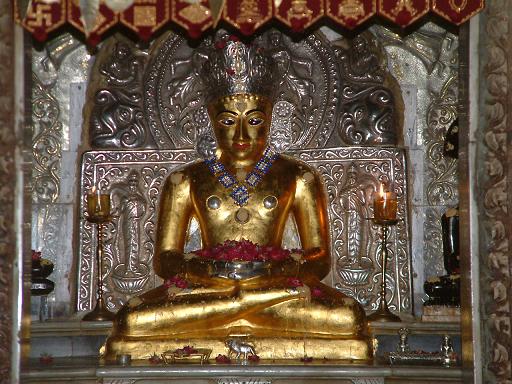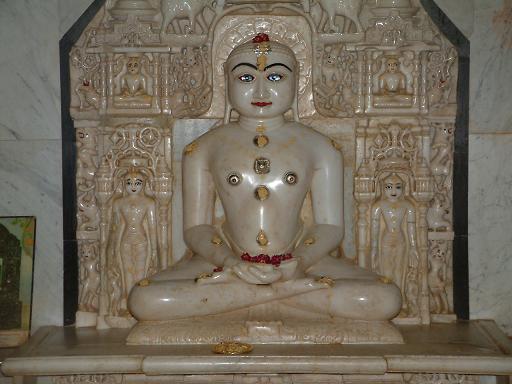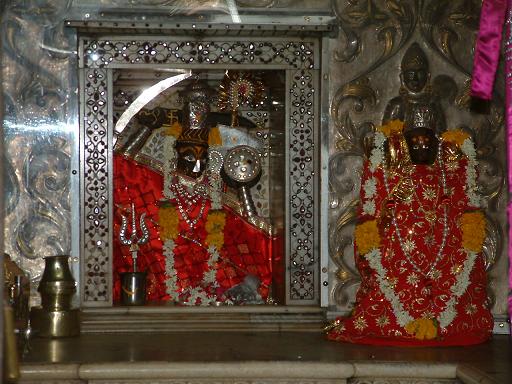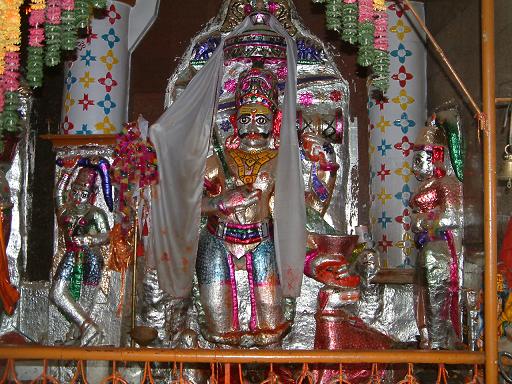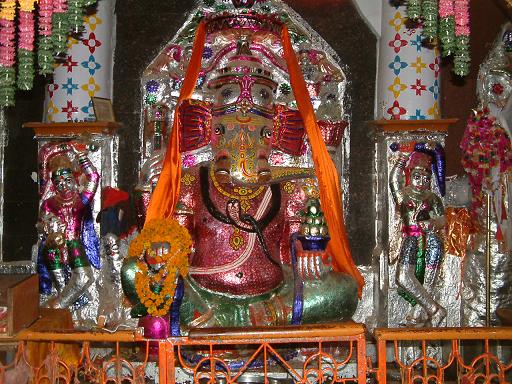Origin of Oswals - Legends and History
The origin of Oswal is disputed, there are three different schools of thought, viz.
- Opinion of Jain Acharyas
- Opinion of Bhats and other communities
- Opinion of Historians
1. Opinion of Jain Acharyas
According to "Upkesh Gachh Pattawali" Acharya Sri Ratna Prabh Suri did his "Chathurmas" in the Veer Sanwat year 70 at Upkeshpur Pattan and he addressed the king and his people and convert to Jainism. Changing religion may seem as a small step but to make a community following non-violence from violence was a historical achievement. He preached that yagya havana were all against the Jainism and made all of them mahajan.
1.1. New Kingdom of Upkeshpur Pattan (City)
Accordingly to "Upkesh Gachh Pattawali", the raja (king) of Srimal Pattan had two sons, named Utpaldev and Sripunj. One day Utpaldev teased his brother, so Sripunj got angry and said: "You are giving me orders as if you have won this kingdom by your own means and power".
Utpaldev immediately realised this and he left the city with his friend Uhad and met Raja Sadhu of Dhelipur (Delhi). With his blessings he built a new city. As the farming of ganna (sugar cane) was done on that place, the name of the city was kept as Upkeshpur, which in a short time became famous as Upkeshpur Pattan. The city was about 12 yojans in length and 9 yojans in breadth. Many traders, scholars, Brahmins settled in this new city of Upkeshpur Pattan.
Image of Mahavira from Shri Mahavir Swami Temple at Osiya (photo from shriosiyamataji.org)
1.2. Acharya Ratna Prabh Suri
The city of Raganpur in the state of Vidyadhar was ruled by Raja Mahendra Chud. The queen Mahadevi Laxmi gave birth to a son who was named Ratna Chud Vidhyadhar. Ratna Chud was a great scholar, very brilliant and had skills in many vidhyas. One day when he was flying in his viman (plane), he stopped near Mount Abu. On inquiry it was found that Acharya Sri Swamprabh Suri was passing by. Ratna Chud got down from his plane and bowed to the Acharya. After hearing the Acharya's he became his disciple and took disksha in the year Veer Sanwat 52 and after getting skilled in various philosophical, intellectual and spiritual rites he became Acharya.
One day, when Acharya Sri Ratna Prabh Suri was touring near Abu, Chakreshwari Devi came and asked Acharya if he could visit Upkeshpur Pattan since the Jain religion could be spread much faster then. So the Acharya along with his 500 disciples reached Upkeshpur Pattan.
In Upkeshpur Brahmins were very powerful. They had blessings from the king in doing havan, yagya etc. and when Acharya came, the Brahmins did not allow the Acharya to enter the city. So the Acharya and disciples were forced to stay on Lunadri mountain. All the saints were under the ritual of maas shraman (fasting for a month) so in the evening after pratikraman (evening prayer) the Acharya ordered to return to Moutn Abu the in the morning.
At night Chamunda Devi came, bowed to Acharya and asked for forgiveness that she had forgotten the message of Chakreshwari Devi because she was busy in dancing. She requested the Acharya that she would create maya so that the citizens will welcome Acharya and disciples. However, in the morning Acharya announced to his disciples, that saints should stay in ghor tapasya and the rest to move elsewhere. So 465 saints left and 35 remained to continue the fasting and tapasya.
The daughter of Raja Utpaldev, named Saubhagya Kumari, got married to Trilok Singh, son of the minister Uhad. A snake bite Trilok Singh at night when they both were sleeping and he died. In the morning when the funeral procession was going, Chamunda Devi appeared in saints form and told people why they were taking a living man for funeral and disappeared.
Everybody discussed and some people told that they had seen similar saints on Lunadri mountain. All went there with the procession, when the Devi appeared in saints dress again and told that the sadhus have divine powers. If they would sprinkle hot water, poured on the Acharya's toe, on the prince's body, he would regain life. This was immediately done and as expected the prince was back to life.
Image of a Tirthankara from Shri Mahavir Swami Temple at Osiya (photo from shriosiyamataji.org)
1.3. The visit of Acharya Ratna Prabh Suri
The whole city was overjoyed. The Acharya and his disciples were treated with full honour and respect and they entered the city. Crowd was cheering with "Jai-Jaikar". Acharya stopped in front of the fort and ordered to remove all luxurious things like carpets etc.; then they could enter. All decoration and luxuries were removed and then Acharya and his disciples entered in the palace. When the king offered jewels to Acharya, he said: "Oh king, we have already left all material things and we remain busy in tapasya and prayers to the almighty, we have no pleasures even in seeing these things". Everyone was surprised.
When the sermon was given then, they found out how much better the Jain religion is. The greater happiness can be found by sacrifice and religious ceremonies. The wealth, prosperity and physical pleasures are worldly desires; they increase sorrow and unhappiness at the end. This road leads to hell while the road to heaven is in sacrifices, donations, dhyan, meditation etc. Before the birth the child faces nine months of acute hell. The pain at the time of labor cannot be explained. By the action of sacrifices and meditation all pleasures can be gained.
In the year Veer Sanwat 70 the Acharya did his chaturmas (where Muni stay in a place for four months) and due to his continued preaching 1500 men became Sadhu and 3000 women became Sadhvi and 140,000 people adopted Jainism.
1.4. The foundation day of Oswals
According to Muni Sri Gyan Sunderji the foundation day of Oswals falls on the fourteenth day of Krishna Paksha in the month of Shravan. All Jain-Oswals celebrate this with sacrifice, prayers and meditation.
1.5. The Kuldevi of Oswals
Maa Jagat Bhawani Shri Sachchiyay Mataji, also called Shri Osiya Mataji, is kuldevi of Oswals. There was a big temple of Chamunda Mata in Upkeshpur presently known as Osiya situated near Jodhpur, Rajasthan. The temple was known for chamatkars and therefore everybody prayed to Chamunda Mata. During navratri, buffaloes were butchered and people gave offerings of flesh of buffaloes to please Chamunda Mata. Acharya Shri Ratna Prabh Suri stopped this practice of animal killing. Because of this, the goddess got angry and she created pain in the eyes of the Acharya. He did not do anything but continued with the suffering. Chamunda Mata was ashamed when she found that Acharya has not reacted to her activity and she asked for forgiveness from the Acharya.
Acharya told her not to allow killing of animals as a sacrifice. He said that she is doing her own harm by asking her devotees to offer flesh of buffaloes or other animals. She will have to face all the wrong done in her name. She was made a goddess because of her good actions but now she will have to face the hell. The goddess got enlightened. She told Acharya that from today no such killings would be allowed in the temple. Even red colored flower should not be offered. She would accept prasad and lapsi. Her worship will be done by kesar, chandan (sandal wood) and dhup (incense sticks). She will be happy as long as people are devoted to Lord Mahavira and she would fulfill all prayer of her devotees. On this, Acharya named her as Sachchi Mata and from that day Chamunda Mata became known as Sachchiyay Mata.
Image of Sachchiyay Mata from Sachchiyaymata Temple at Osian (photo from shriosiyamataji.org)
1.6. The Jain Mandir of Lord Mahavira at Osiya
It is believed and said that Sachhiyay Mata was devoted in the bhakti of lord Mahavira so much that she decided to build a temple for Lord Mahavira.
Now a very mysterious occurence happened. The king of Upkeshpur had a holy cow. Every day in the evening when the cow returns from jungle, she had no milk left. This continued for a while. The person looking after the cows was asked to explain why at this particular place cows carried no milk. The shepherd explained that while the cow was roaming in a heightened land the milk flowed out from her automatically in all the four directions and when the milk was finished the cow returned to the herd. Next day, then, same scene was seen by thousands of people. King Utpaldev was informed of the incident and next day the king with his prime minister and several thousand people gathered and saw the scene. The king narrated the incident to Acharya who understood that this was the work of Chamunda Devi. Next day at the auspicious hour, the place was dug up and an image of Lord Mahavira, covered with gold, and nine laks gold coins were found. Later a temple was built and it is said that the opening pratistha (the way in which an idol is installed) was done by Acharya Sri ji on the 5th day of shukla panchami in the year Veer Samvat 70. At the same time Acharya by using his supernatural powers did pratistha simultaneously in another temple dedicated to Lord Parshvanatha,located in Konarpur which was miles away from Osiya.
2. Opinion of Bhats and other communities
According to the writing of Bhats and other communities, the Oswal community was founded in year Vikram Sanwat 222. However, Jagga Shah of Abha Nagri made a procession of Oswals in 222 and Jagga Shah was Oswal. According to this Oswals were in existence even before 222 but they were called Mahajans and not Oswals.
It is believed that before 222 all Oswals were of Mahajan community. In year 222 there was a meeting of Mahajans in Khandela (near Jaipur) where Mahajans from Osiya (Upkeshpur), Srimal Nagar, Khandela, Pali, Agrova, Pragvat Nagar attended and from that day all the Mahajans were named according to their places, e.g. from Osiya Oswals, from Srimal Srimali, from Khandela Khandelwal, from Pali Palliwal, from Agrova Agarwal and from Pragvat Porwal. Therefore, Mahajans came in existence in 70 CE and Oswals in 222 CE.
Shri Bheruji Temple at Mandore (photo from shriosiyamataji.org)
3. Opinion of Historians
Most of the historians, e.g. Sri Pooran Chand Nahar, Dr. Bhandarkar, Agarchand Nahata, Hira Chand Ojha, Jagdish Singh Ghelot, Mohnot, Nensi assume that Oswals came in existence during the period between 70 AD and 222 AD.
Dr. Bhandarkar argued that Utpaldev once asked the Parihar king for shelter. The Parihar king gave the permission to re-build Bhelpur Pattan and it is said that shelter which was given is called Oslakiya (means: to take shelter) which later on was turned as Osiya. This was in 9th century. According to Sohan Raj Bhansali the Oswals started from 8th century.
4. Conclusions
The Bhat, other communities and the historians have accepted Utpaldev as Parmar after seeing his name in Upkesh gachh Pattawali and concluded that he is the founder of Oswal dynasty. Otherwise, just by the mentioned name of Utpaldev in Parmar dynasty it cannot be concluded definitely that Oswals originated from there.
According to poet Rishab Das' explanations in his work "Hari Vijay Sri Ras", Agar Chand Nahata concludes that Oswals originated in 510 by Sri Ratna Suriji.
According to Mahir Stavan and Oswal utpati Vratant it is Vikram Sanvat 1011 - 15 while Dr. Laxmi Mal Singhvi assumed that Oswal originated from 5th century BC and Bhansali suggested the formation of the Oswals in the 8th century. Sri Sukh Sampat Raj Bhandari mentioned Vikram Samvat 508 as the year of formation.
According to "Mathuri Vachan", Skandal Suri (357-360) stated about Mathura resident Oswal Polak who made description on the Tadpatra and gave to various saints there. That means Oswals were in existence in Mathura before 4th century.
According to Col. Todd hundreds of people of kshatriya community settled in Osiya gram and were later called Oswals.
We may conclude that the Mahajans originated in VS 70 and later were called Oswals or they might have been named as Oswals in VS 222.
Shri Bheruji Temple at Mandore (photo from shriosiyamataji.org)

